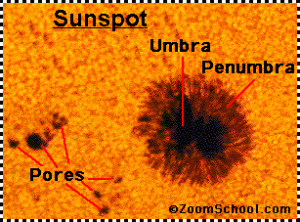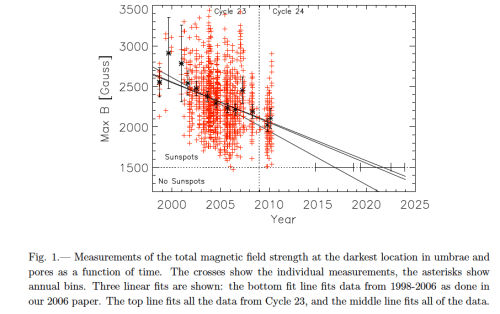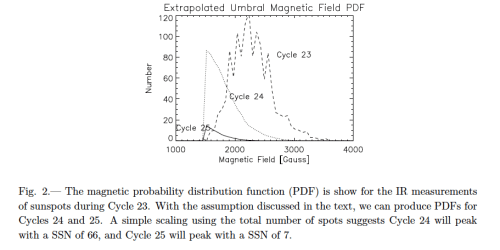Penn and Livingston, in their September 2010 IAU publication “Long-Term Evolution Of Sunspot Magnetic Fields” predicted that Solar Cycle 24 would peak at an International Sunspot number of 66 and Solar Cycle 25 at 7!!
Considering that NASA believes that the peak for Cycle 24 will be 67, their prediction looks pretty good. So would you bet against their Cycle 25 prediction of 7?
Some background— the authors have observed that the magnetic field within the Sunspot’s umbra’s (the dark part of the spot) has been weakening. As the field gets weaker, the umbra becomes less dark. From their work, below 1500 gauss no Sunspots can be observed. The following chart is from their publication: (Click on charts to enlarge.)
Their 2006 paper on this topic had the Sunspot linear fit line crossing the 1500 gauss line in 2017. The early Cycle 24 measurements moved the crossing to about 2021– (The middle line.)
The authors say: “Secondly, the intercept of the mean magnetic field strength of 1500 gauss threshold does not imply that all sunspots will disappear in 2021; rather it implies that half of the sunspots which would normally appear on the surface of the Sun would be visible.”
Lets look at the current data:
 Chart from Lief.org
Chart from Lief.org
At first glance one might conclude that the intercept of the 1500 gauss line is going future out in time. But in fact the mean line for the Sunspot umbral gauss will always be above the 1500 as there are no Sunspots below the line. This would seem to prove the Penn and Livingston premise.
The upper chart, Umbral Intensity, is the inverse of the bottom chart. As the umbral gauss approaches 1500, the spots would get less dark until they match the unperturbed Sun surface intensity—and thus no longer visible.
The projections of the number of Sunspots in Cycles 24 and 25 were based upon the author’s use of magnetic probability distribution function. The results are plotted on the following chart:
Lets guess at the start and finish time of Cycles 24 and 25. December 2008 was declared by the experts to be the start of Cycle 24. If it goes the nominal 11 years, it should end December 2019. Cycle 24’s maximum is happening now, some 5 years after its start. Cycle 25 would begin December 2019 and run to 2030. The maximum for Cycle 25 would be roughly 2024. The authors have given us 2021 as the intercept of the 1500 gauss line. That would suggest that the Sunspot numbers in Cycle 25 would be minimal.
This is pretty interesting as the Penn and Livingston theory is beginning well. But like all theories, it needs more time to be proven.
(Side note—-a typical refrigerator magnet has a gauss measurement about 50.)
cbdakota




Pingback: Sonne kurz vor ihrem langen Schlaf | Wetter-Observer.de
I personally believe the trend has turned (Im just a “HAM”, not scientist 🙂 ). The last few cycles has had dual peaks in solar activity, where the second peak has been lowest. In cycle 24, the second peak is stronger than the first. (The peaks indicate peak of the northern and southern hemisphere on the sun.
Just look here: http://www.solen.info/solar/images/cycles23_24.png
If you look at the strength of the umbral field, the actual measurements seem to have left the downward trend (but a bit hard to confirm yet).
The statements from 2006 is from a period when the scientists said cycle 24 was going to be way stronger than 23…
Solar predictions are still in the stone age it seems, but its interesting to see what progress the next years will bring.